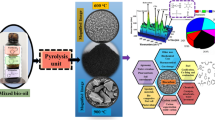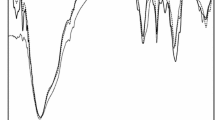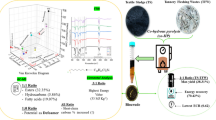Abstract
In order to reduce dependence on imported crude oil and to progress towards self-reliance in energy, it is desirable to develop processes for producing fuels from renewable resources like bio-based feedstocks. However, it is observed that use of biocrude in a Petroleum Refinery is limited by extensive corrosion of Refinery equipment due to the presence of Naphthenic acids at high levels to the tune of > 90 mg KOH/gm. As part of the study, detailed study on biocrude is carried out and found that 46 vol% fraction of biocrude is having boiling range of 643.15°K–753.15°K and has a high tendency of coke formation. To investigate the behaviour of thermal cracking and extract kinetic parameters, different model-free techniques such as the Friedman, Flynn–Wall–Ozawa and Kissinger–Akahira–Sunose method are employed from the Thermogravimetric and Differential Scanning Calorimetry analysis. The experimental results showed that activation energy obtained from isoconversional methods showed good agreement, but Friedman method was considered to be the best among the model-free methods to evaluate kinetic parameters of highly stable materials like biocrude and VR with activation energy ranging from 53 to 92 kJ mol−1 and 159 to 234 kJ mol−1, respectively, for extent of conversion from 10 to 50 mass%. A thermal cracking study in laboratory scale Micro-coker unit was also carried out by co-processing the biocrude with vacuum residue, to study the feasibility of co-processing in Delayed Coker Unit. Thermal decomposition of biocrude also showed considerable reduction in the Total Acid Number from 90 to 18 mg KOH/gm.
Graphical Abstract

















Similar content being viewed by others
References
Yakovlev VA, Khromova SA, Sherstyuk OV, Dundich VO, Ermakov DYu, Novopashina VM, Lebedev MYu, Bulavchenko O, Parmon VN. Development of new catalytic systems for upgraded bio-fuels production from bio-crude-oil and biodiesel. Catal Today. 2009;2009(144):362–6. https://doi.org/10.1016/j.cattod.2009.03.002.
Dundich VO, Khromova SA, Ermakov DY, et al. Nickel catalysts for the hydrodeoxygenation of biodiesel. Kinet Catal. 2010;51:704–9. https://doi.org/10.1134/S0023158410050113.
Kalinina MA, Kulikov LA, Cherednichenko KA, et al. The effect of sulfonate groups in the structure of porous aromatic frameworks on the activity of platinum catalysts towards hydrodeoxygenation of biofuel components. Pet Chem. 2021. https://doi.org/10.1134/S0965544121090115.
Nepomnyashchiy AA, Buluchevskiy EA, Lavrenov AV, et al. Hydrodeoxygenation of vegetable oil on NiMoS/WO3–Al2O3 catalysts. Russ J Appl Chem. 2017;90:1944–52. https://doi.org/10.1134/S1070427217120084.
Almasi S, Najafi G, Ghobadian B, et al. Waste to fuel: biodiesel production from bitter orange (Citrus aurantium) seed as a novel bio-based energy resource. Biomass Conv Bioref. 2021. https://doi.org/10.1007/s13399-021-01635-2.
CeciliaVásquez M, Silva EE, Castillo EF, et al. Hydrotreatment of vegetable oils: a review of the technologies and its developments for jet biofuel production. Biomass Bioenerg. 2017;105:197–206. https://doi.org/10.1016/j.biombioe.2017.07.008.
Zacher AH, Olarte MV, Santosa DM, Elliott DC, Jones SB. A review and perspective of recent bio-oil hydrotreating research. Green Chem. 2014;16(2):491–515. https://doi.org/10.1039/C3GC41382A.
Sachdeva A., Sharma U. (2020) An overview of utilization of e-waste plastic in road construction. In: Kanwar V., Shukla S. (eds) Sustainable Civil Engineering Practices. Lecture Notes in Civil Engineering, vol 72. Springer, Singapore. https://doi.org/10.1007/978-981-15-3677-9_11
Mondal BK, Guha F, Abser MN. Waste plastics-to-fuel using fly ash catalyst. Waste Dispos Sustain Energy. 2021;3:13–9. https://doi.org/10.1007/s42768-020-00058-5.
Cakici A, Yanik J, UÇar, S., et al. Utilization of red mud as catalyst in conversion of waste oil and waste plastics to fuel. J Mater Cycles Waste Manag. 2004;6:20–6. https://doi.org/10.1007/s10163-003-0101-y.
Alam SS, Churkunti PR, Depcik C. Comparison of waste plastic fuel, waste cooking oil biodiesel, and ultra-low sulfur diesel using a Well-to-Exhaust framework. Int J Environ Sci Technol. 2021. https://doi.org/10.1007/s13762-021-03552-3.
Tomar M, Jain A, Pujari PC, et al. Correction to: Potentials of waste plastic pyrolysis oil as an extender fuel for diesel engine. Arab J Geosci. 2020;13:799. https://doi.org/10.1007/s12517-020-05823-8.
Nanda S, Berruti F. Thermochemical conversion of plastic waste to fuels: a review. Environ Chem Lett. 2021;19:123–48. https://doi.org/10.1007/s10311-020-01094-7.
Agblevor FA, Mante O, McClung R, Oyama ST, et al. Co-processing of standard gas oil and biocrude oil to hydrocarbon fuels. Biomass Bioenerg. 2012;2012(45):130–7. https://doi.org/10.1016/j.biombioe.2012.05.024.
Castello D, Haider MS, Rosendahl LA. Catalytic upgrading of hydrothermal liquefaction biocrudes: different challenges for different feedstocks. Renew Energy. 2019;141:420–30. https://doi.org/10.1016/j.renene.2019.04.003.
Barreiro DL, Gómez BR, Ronsse F, Hornung U, Kruse A, Prins W, et al. Heterogeneous catalytic upgrading of biocrude oil produced by hydrothermal liquefaction of microalgae: State of the art and own experiments. Fuel Process Technol. 2016;2016(148):117–27. https://doi.org/10.1016/j.fuproc.2016.02.034.
Sanguineti MM, Hourani N, Witt M, Sarathy SM, Thomsen L, Kuhnert N, et al. Analysis of impact of temperature and saltwater on Nannochloropsis salina bio-oil production by ultra high resolution APCI FT-ICR MS. Algal Res. 2015;9:227–35. https://doi.org/10.1016/j.algal.2015.02.026.
Sudasinghe N, Dungan B, Lammers P, Albrecht K, Elliott D, Hallen R, Schaub T, et al. High resolution FT-ICR mass spectral analysis of bio-oil and residual water soluble organics produced by hydrothermal liquefaction of the marine microalga Nannochloropsis salina. Fuel. 2014;119:47–56. https://doi.org/10.1016/j.fuel.2013.11.019.
Shin S, Im SI, Nho NS, et al. Kinetic analysis using thermogravimetric analysis for nonisothermal pyrolysis of vacuum residue. J Therm Anal Calorim. 2016;126:933–41. https://doi.org/10.1007/s10973-016-5568-6.
Díaz FA, Chaves A, Maradei MP, Fuentes D, Guzmán A, Picon H, et al. Kinetic analysis of the thermal decomposition of Colombian vacuum residua by thermogravimetry’. Ing e Investig. 2015;35(3):19–26. https://doi.org/10.15446/ing.investig.v35n3.49498.
Schucker RC, et al. Thermogravimetric determination of the coking kinetics of arab heavy vacuum residuum. Ind Eng Chem Process Des Dev. 1983;22:615–9. https://doi.org/10.1021/i200023a011.
Vyazovkin S. A time to search: finding the meaning of variable activation energy. Phys Chem Chem Phys. 2016;18(28):18643–56. https://doi.org/10.1039/C6CP02491B.
Maryandyshev P, Chernov A, Lyubov V, et al. Investigation of thermal degradation of different wood-based biofuels of the northwest region of the Russian Federation. J Therm Anal Calorim. 2015;122:963–73. https://doi.org/10.1007/s10973-015-4798-3.
Mothé CG, de Miranda IC. Study of kinetic parameters of thermal decomposition of bagasse and sugarcane straw using Friedman and Ozawa–Flynn–Wall isoconversional methods. J Therm Anal Calorim. 2013;113:497–505. https://doi.org/10.1007/s10973-013-3163-7.
Wako FM, Reshad AS, Goud VV. Thermal degradation kinetics study and thermal cracking of waste cooking oil for biofuel production. J Therm Anal Calorim. 2018;131:2157–65. https://doi.org/10.1007/s10973-017-6760-z.
An H, Li Y, Hua F, et al. Kinetic analysis of catalytic slurry oil pyrolysis using thermogravimetric analysis. J Therm Anal Calorim. 2020;142:1469–75. https://doi.org/10.1007/s10973-020-09559-1.
Demiral I, Atilgan NG, Şensöz S. Production of biofuel from soft shell of pistachio (Pistacia vera L.). Chem Eng Commun. 2008;196(1–2):104–15. https://doi.org/10.1080/00986440802300984.
Singh Chouhan AP, Singh N, Sarma AK, et al. A comparative analysis of kinetic parameters from TGDTA of Jatropha curcas oil, biodiesel, petroleum diesel and B50 using different methods. Fuel. 2013;109:217–24. https://doi.org/10.1016/j.fuel.2012.12.059.
Carrasco F, Pérez-Maqueda LA, Sanchez-Jimenez PE, Perejón A, Santana OO, Maspoch ML. Enhanced general analytical equation for the kinetics of the thermal degradation of poly (lactic acid) driven by random scission. Polym Test. 2013;32(5):937–45. https://doi.org/10.1016/j.polymertesting.2013.04.013.
Budrugeac P, Segal E. Applicability of the Kissinger equation in thermal analysis. J Therm Anal Calorim. 2007;88:703–7. https://doi.org/10.1007/s10973-006-8087-z.
Ozawa T. Applicability of friedman plot. J Therm Anal. 1986;31:547–51. https://doi.org/10.1007/BF01914230.
Acknowledgements
We acknowledge IOCL R&D Centre for providing state of art analytical facilities and granting permission to publish this paper relevant feed and coke samples.
Author information
Authors and Affiliations
Contributions
JB contributed to conceptualization, data curation, visualization, investigation, and writing—original draft, reviewing and editing. SAD contributed to data curation, visualization, and supervision. PPR contributed to data curation, visualization, supervision, and validation. RK contributed to formal analysis (TGA). SKD contributed to supervision, validation, approval and editing of the manuscript in various domains and occasions. JC contributed to supervision, validation, approval and editing of the manuscript in various domains and occasions. MS contributed to supervision, validation, approval and editing of the manuscript in various domains and occasions. GSK contributed to supervision, validation, approval and editing of the manuscript in various domains and occasions. SSVR contributed to supervision, validation, approval and editing of the manuscript in various domains and occasions.
Corresponding author
Ethics declarations
Conflict of interest
The authors declare that they have no known competing financial interests or personal relationships that could have appeared to influence the work reported in this paper.
Additional information
Publisher's Note
Springer Nature remains neutral with regard to jurisdictional claims in published maps and institutional affiliations.
Rights and permissions
Springer Nature or its licensor (e.g. a society or other partner) holds exclusive rights to this article under a publishing agreement with the author(s) or other rightsholder(s); author self-archiving of the accepted manuscript version of this article is solely governed by the terms of such publishing agreement and applicable law.
About this article
Cite this article
Jitumoni, B., Dixit, S.A., Pradeep, P.R. et al. Study of thermal cracking kinetics and co-processing of biocrude in thermal residual upgradation unit for converting ‘waste to energy’. J Therm Anal Calorim 148, 3439–3456 (2023). https://doi.org/10.1007/s10973-023-11941-8
Received:
Accepted:
Published:
Issue Date:
DOI: https://doi.org/10.1007/s10973-023-11941-8




